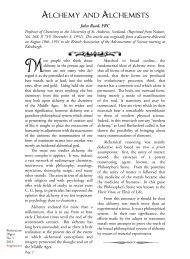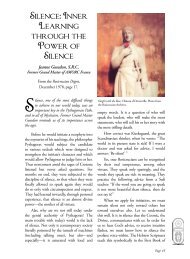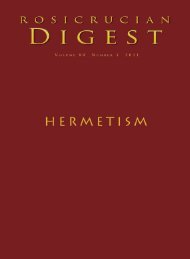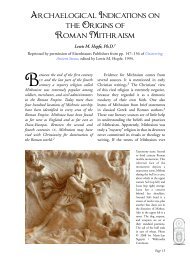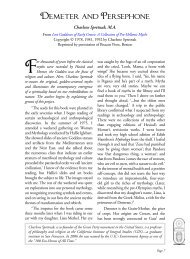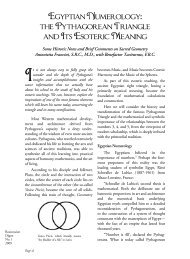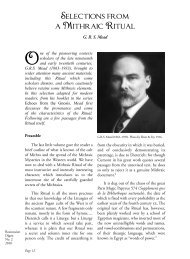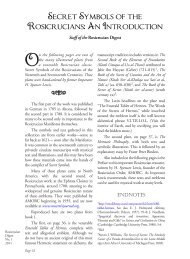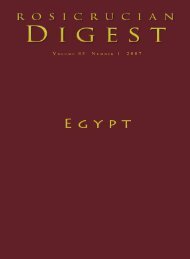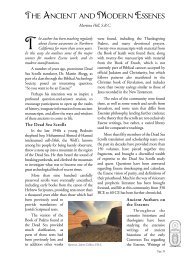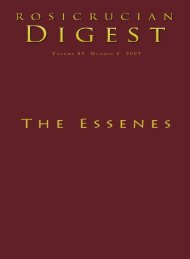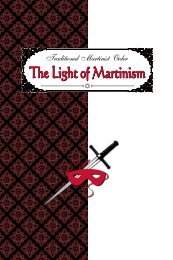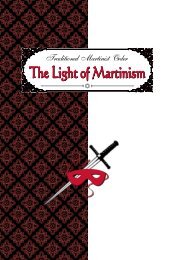Rosicrucian Digest Vol 89 No 2 2011 Gnosticism - Rosicrucian Order
Rosicrucian Digest Vol 89 No 2 2011 Gnosticism - Rosicrucian Order
Rosicrucian Digest Vol 89 No 2 2011 Gnosticism - Rosicrucian Order
Create successful ePaper yourself
Turn your PDF publications into a flip-book with our unique Google optimized e-Paper software.
things created. Saying 50 can be construed as<br />
saying that life is motion and its requisite,<br />
rest. Thus, without motion there is no life,<br />
and without rest there is no reflection on<br />
life. With motion and rest, with life and<br />
reflection, a story develops as events take<br />
shape, becoming activities, as a series of<br />
motions are flawlessly executed so that a<br />
thing is accomplished; that “thing” being<br />
perhaps the placing of one foot before the<br />
next, taking a step. Consider doing this now,<br />
to stand and take a step with your foot. This<br />
is “motion,” and to reflect on it and to begin<br />
contemplating upon where that foot will<br />
land is “rest.” It is “making a foot in place of<br />
a foot”—the imagined foot landing where<br />
the foot is to land.<br />
This territory, called self-awareness, is not<br />
unfamiliar to a Hindu, Buddhist, or Chinese<br />
Taoist. It is unfamiliar to the West. For the<br />
West has taken step after step, moving foot<br />
after foot, putting little thought into the<br />
exercise, instead contemplating only upon<br />
the end destination. “I’m going to build a<br />
patio,” a person might say. But that person<br />
does not put thought into the totality of each<br />
of the separate movements that will combine<br />
for achieving it. The person ends up with<br />
a patio, but has traded self-awareness for<br />
it. This is okay, for a patio is of great value.<br />
But the patio would be more enjoyable had<br />
the person gained, or at least avoided losing,<br />
self-awareness.<br />
Such is the way of Western humanity;<br />
creating exceptional fine forms yet losing our<br />
essence. And the Eastern mystic? He or she<br />
has self-awareness, but may not have a patio.<br />
To “make eyes in place of an eye, a hand in<br />
place of a hand,” is to contemplate on your<br />
every movement. To make “an image in place<br />
of an image” is to reverse the order of Divine<br />
Power; to make the image with your mind,<br />
so that your mind is no longer enslaved by<br />
the images and sensations that perpetually<br />
surround you in your waking life. The<br />
building blocks for this task are motion and<br />
rest. All of the gospels and other texts of Jesus,<br />
even those bound into the New Testament,<br />
were written after the ministry of Jesus had<br />
ended. Historians generally give greater<br />
credibility to those written earliest, because<br />
they are less influenced by pagan Roman,<br />
Greek, and other beliefs. Marvin Meyer, a<br />
professor of religion at Chapman University<br />
in Southern California, is a foremost<br />
recognized expert on historical Gnostic and<br />
orthodox Christian written doctrines. The<br />
Nag Hammadi Scriptures, edited by Meyer<br />
contains his translation of the Gospel of<br />
Thomas from the original manuscript, as<br />
well as his commentary. Based on evidence<br />
from earlier-found page fragments of the<br />
Thomas Gospel, this gospel may be from<br />
a very early date, according to Meyer who<br />
cites the work of leading papyrologist Soren<br />
Giversen. Meyer concludes that it may<br />
rival “that of any of the New Testament<br />
gospels,” in regard to how soon the gospel<br />
was recorded in writing after the ministry of<br />
Jesus was done. And “in literary genre and<br />
content” the gospel is consistent with some<br />
earliest known texts, says Meyer. Gospel of<br />
Thomas sayings appear to be transmitted in<br />
an earlier form than the canonical, orthodox<br />
gospels. Thomas parables of Jesus appear<br />
simply as stories, yet New Testament gospels<br />
often have “allegorical interpretations”<br />
appended to them that appear to reflect “new<br />
situations” experienced by Jesus followers.<br />
The early written Thomas Gospel may be<br />
more reliably closer to what Jesus thought.<br />
Second-century church officials spoke of<br />
the Thomas Gospel, among others in use at<br />
the time by the various largely unorganized<br />
Christian churches, but key Church leaders<br />
declared these other gospels to be heretical,<br />
and condemned them. Meyer notes that<br />
they seem to have intended to limit the<br />
number of valid gospels to four, and this<br />
was without a scientific basis. The subjective<br />
nature on which some books were bound<br />
into the New Testament and which others<br />
Page 19




